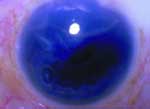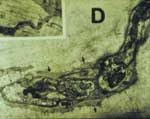Laser surgery procedures go in and out of vogue, interest waxes and wanes, prices ebb and flow, discounters come and (mostly) go and the media falls in and out of love with laser vision correction. But the one thing that hasn"t changed is the use of contact lenses to solve post-surgical problems. Be it undercorrection and overcorrection, induced irregular astigmatism, anisometropia and aniseikonia or fluctuating vision, contact lenses are a safe and effective treatment for our patients" altered corneas. Their scarred emotions? That"s another story (see "Misadventures in Expectations Management" on page 35).
Acuity as good as RGP-corrected vision?
Contact lens fitting is difficult on any patient who has had a less-than-expected outcome following elective refractive surgery. A natural apprehension exists, prior to surgery, about losing visual function and expectations for postoperative outcomes are high. If a lesser result is obtained, the patient may become quite upset -- even depressed.
This is not to say that patients won"t justify their decision to have had surgery, even if significant visual loss results. Fortunately, the great majority of LASIK patients are happy with their results. Studies have led to significant improvement and predictability in refractive procedures, and new procedures are under investigation that will add to our armamentarium of correcting visual ametropias. However, rigid gas permeable lens-corrected visual acuity remains the gold standard by which other visual results are measured.
The post refractive surgery patient"s altered corneal shape sometimes makes fitting contact lenses more challenging. Whether the contact fit will be challenging many times depends on what type of lens you use. The nature of the problem usually dictates the complexity of the treatment. For the most part, soft lenses are relatively easy to fit. They"ll either work or they won"t. For cases involving spherical undercorrection and overcorrection, anisometropia or aniseikonia, a simple soft lens fit is ideal. For night vision problems, an aspheric soft lens can be very helpful.
Aspheric soft lenses block spherical aberration that is located in the periphery. Many times, a large pupil greater than the ablation zone size induces glare at night. Aberration-blocking lenses are often the first choice treatment when dealing with post-LASIK patients.
If you can remedy the problem with a soft lens fitting, the problem is minor. These patients generally are candidates for enhancement unless the residual bed is too thin. When a soft lens does not work, the next step is a rigid lens. Fitting a rigid lens to an altered cornea requires more time and expertise. The number-one reason for using a rigid lens is irregular astigmatism following refractive surgery. Fortunately, irregular astigmatism is not as common with LASIK as with older refractive surgery procedures. Here"s a review.
LASIK. LASIK has become the procedure of choice for mild to moderately high myopia correction. Reported complications types and rates vary and are thought to be inversely related to surgeon experience. In LASIK as with other forms of keratorefractive surgery, irregular astigmatism is the primary reason for seeking post-operative contact lens correction. Hydrogel lenses may be used to correct simple ametropias with spherical and regular cylinder components, but RGP lenses offer the best possible visual performance by providing a smooth, regular anterior refractive surface to the eye. Tears fill the spaces between the posterior RGP lens surface and the anterior cornea, thus providing an optical bridge and minimizing the light scattering effects created by the irregular corneal surface.
PRK/LASEK. You should use an initial RGP base curve approximately 0.50D flatter than the flat preoperative keratometry reading. Therefore, this is just like fitting an alignment RGP on an unoperated eye. Larger than normal diameters are used to aid in lens centration; overall lens diameters of 9.5mm to 10.5mm are common and aid in upper lid attachment. Corneal topography is used to determine if the ablation zone is decentered, as this could be the reason for not obtaining a stable lens fit in some patients.


A large RGP over LASIK. (Courtesy: Michael A. Ward, MMSc)
Phakic IOL. (Courtesy: Michael A. Ward, MMSc)
RK. The lens type lens of choice for the post-RK patient is a rigid gas permeable (RGP) lens. RGP lenses can offer greater oxygen transmissibility, fewer lens surface deposits and an irregular astigmatism compensating tear film. Soft contact lenses are not a good option for post-RK fits since they cannot correct the residual irregular surface astigmatism. These lenses are prescribed for simple over-corrections and under-corrections if the patient is unable to tolerate an RGP lens, and if the RK incisions do not extend to the limbus. RK incisions extending to the corneal limbus predispose the patient for neovascularization. The high Dk PureVision lens (Bausch & Lomb) or Focus Night & Day (CIBA Vision) provide ample amounts of oxygen to these surgically altered corneas and can be quite useful if they give acceptable acuity. Toric soft-contact lenses can correct regular astigmatism (principle axis 90 apart), but are not capable of correcting irregular astigmatism, which is the usual indication.
DePaolis et al. have determined that an initial contact lens base curve should be determined by subtracting one-third of the refractive error reduction from the preoperative flat keratotomy. For example, the preoperative keratotomy readings are 43.00 X 44.00 and the RK myopic reduction is 2.00 D. To select an initial base curve one would take [43.00 - 1/3(2.00)], or 42.30. Modifications are then based on fluorescein evaluation, vision and lens stability. Aspheric rigid lenses are another option because of their junctionless curves and ability to mask astigmatism.
Large lens diameters (9.5 to 11.5 mm) facilitate lid attachment with mid-peripheral corneal fitting. However, the practitioner must be wary of lens-to-cornea relationships as the diameter of the lens increases. The curvature may not match the post-RK cornea and cause decentration and lens adherence.
Mr. Ward (mward@emory.edu) is director of the contact lens service at Emory University Eye Center and an instructor in ophthalmology at Emory University School of Medicine.
|
Post-LASIK Complications Ward recently reported on 35 eyes of 22 patients requiring contact lens correction following LASIK. Types of complications that limited visual function following surgery were eccentric ablations, corneal ectasias, scars and irregular astigmatism. Preoperative spherical equivalent refractions ranged from 2.38 to 14.25D. RGP contact lens designs included spherical myolenticular, aspherical and custom designs. Lens diameters ranged from 9.2 to 10.9mm, with a mean diameter of 10.2mm and the most common diameter as 10.5mm. An evaluation of the relationship of the contact lens base curve to corneal curvature suggests that an initial RGP base curve selection should be approximately 2 diopters steeper than the mean post-operative keratometric power. Visual outcomes improved with RGP lenses. There was a loss of best spectacle-corrected visual acuity from the preoperative mean of 20/25 to the postoperative mean of 20/40 following LASIK in these patients. RGP lenses provided a median change in visual acuity from approximately 20/70 unaided, to 20/20 with rigid lenses. SOURCE: Visual Rehabilitation with Contact Lenses After Laser in situ Keratomileusis. J. Refractive Surgery, Vol.17; 433-440, July/August 2001. |

